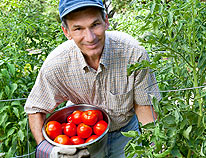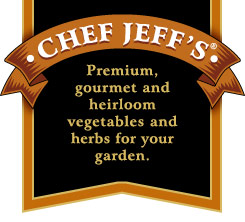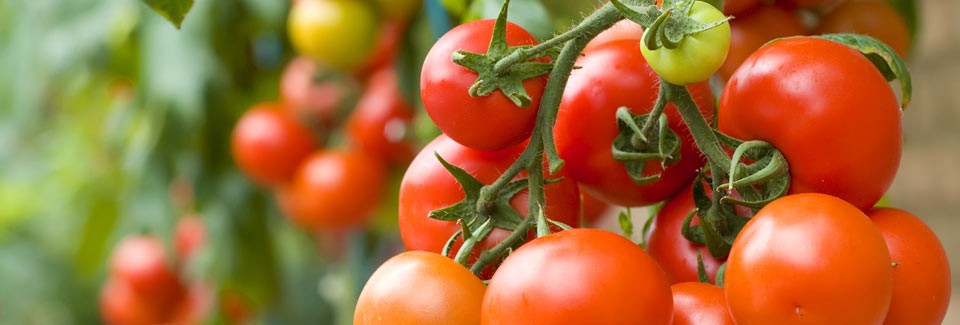COMMON TERMS
Determinate: Determinate tomatoes are varieties that once mature will set and ripen all their fruit in a short period. Determinates produce well for a 2 week period. Often called bush tomatoes, the plants are sturdy and perfect for containers.
Indeterminate: Larger plants that require staking and will produce the whole season. Tomatoes develop in several stages, constantly reflower and reset fruit. The largest size tomatoes will come from indeterminate types.
Take advantage the differences of determinates and indeterminates and plant some of each. Determinates will offer a bountiful harvest for immediate uses and you’ll still have a steady supply of tomatoes throughout the season from the indeterminates!
Hybrids: Plants developed by breeders for disease resistance, production and flavor. Plants are produced by cross breeding two or more different tomato varieties to take on positive traits of the parent tomato types. If hybrid tomatoes seeds are replanted, the plants will not return with the same selected qualities. Hybrids offer good disease resistance and production.
Heirloom: When the seed has been saved and grown at least 50 years or more and has been passed down from generation to generation. An heirloom is also open-pollinated, which means the plant is capable of producing seeds that will grow a new plant identical to the parent plant from which the seed originated. Heirlooms offer great taste, unique colors, shapes and sizes.
 PLANTING TIPS
PLANTING TIPS
Proper soil temperature
Tomatoes should be planted when the soil temperature reaches 60˚ or warmer and daytime air temperatures a minimum of 60˚and 50˚or warmer at night. Tomatoes planted in cold soil can be easily shocked and may not recover to produce a healthy harvest. Patience will pay offer in the long run! Plants purchased early can be transplanted into black 1 gallon pots. Leave the plants out during warm days. At night, move them inside or place them in a sheltered area and cover them. Plants cared for this way will develop a larger root system and are ready to go when the soil warms up! Southern zones face a different problem when soil temperatures combined with excessive air temperatures may damage transplants. In this case, a shade cloth should be used to protect transplants along with mulching to keep the transplants cooler. Pay special attention to watering.
Planting
Tomatoes benefit by a common garden mistake of being “planted too deeply”. Tomatoes will develop roots (Adventitious roots) up the buried stems. Chef Jeff plants are raised for a thick, vibrant root system. This easy- to- do planting method will add even more roots for the very best production.
Here are some easy planting techniques. When you get the hang of this method, planting should go quick and easy!
- Your shovel is both a depth gauge and a volume measure!
- Once your garden is cultivated you’re ready to start planting.
- If you can pick a day, transplant on a cool and overcast one. If there’s rain on the way, that’s even better!
- Bring the family out into the garden to help. Get the camera ready because now could be the start of a little family competition. Who grew the biggest or most tomatoes?!
Supplies:
F Compost — One shovel of compost works fine for plants in 4 inch to quart containers. Use 2 shovels per 1 gallon pot.
F Fertilizer (your selection)
F Calcium supplements (optional but recommended) – Bone Meal, crab shell, dolomitic lime stone (for acidic soils)
or Gypsum (for alkaline soils)
- Make sure your plants are well watered the morning of planting.
- Mark off your planting spots from your garden sketch. (Bone meal works great for marking planting spots)
- Work in a heaping shovel full of compost as deeply as possible on the planting spot (This mixes soil with compost)
- Rake the spot level.
- Take another good dig in the center of that spot- that’ll be the planting hole
- Place that shovel of soil-compost mix around the planting hole you just dug
- Mix fertilizer into soil around the planting hole; Calcium supplements should also be added at this time.
- Put a half shovel of the compost, fertilizer, soil mix back in the hole.
- Remove the tomato from the container and gently loosen the roots. Try to leave soil on the root ball in place.
- Plant the tomato so the soil line is about 1 inch below the lowest branch.
- Fill in with the surrounding soil, firm in place, and water thoroughly. Apply a water soluble starter fertilizer.
Mulching
Mulching conserves water, keeps the roots cool, adds organic matter and keeps weeds out. A layer of mulch will act as a buffer between the soil and the plant preventing soil borne fungal problems. Mulch transplants after they establish and the soil warms. In southern areas, mulch rights after planting to conserve water and keep the roots cool. Mulches should be put down at least 3-4 inches thick to be effective. Add mulch as needed during the growing season.
Mulching materials could be compost, straw (seed free), pine straw, pine needles, lawn clippings, and newspapers.
Do not mulch or compost lawn clippings or plant materials on which herbicides, fungicides or pesticides were used. You may introduce potentially dangerous chemicals into the garden. Wood chips work as a mulch, but should not be turned into the soil because of nitrogen tie up in the soil.
 Staking
Staking
Indeterminate tomatoes should be staked as soon possible. Do not let the plant get too tall without support; they can easy be broken from a heavy wind. Determinate plants should be sturdy enough without a support at first. Later as the plants bear fruit, staking may be necessary to help them support the weight of the fruit.
Attach the tomato plant to the stake using a tie that won’t cut into the branches. There’s a huge assortment of soft tomato ties available commercially; many are reusable. Recycled house items like strips cut from old pillow cases or nylon socks will also work. Heavy gauge plastic coated electrical wire will work and can be reused. Leave a little room for growth if you use twist ties or electrical wire. Indeterminate tomatoes will grow fairly large, so it’s a good idea to use cages along with staking. The tomatoes will need some support for the branches, especially during fruiting. The trick is to install the cages before the plant gets too large. Folding cages are available and easy to store. Various other tomato support systems are available at the garden center where you purchased your Chef Jeff Vegetables and Herbs.
Pruning
Pruning helps direct the tomatoes energy into fruit production rather than foliage growth. Proper pruning opens the plant up for better sunlight (aids photosynthesis) and better air flow for less fungal problems. Healthy leaves that receive plenty of sunlight manufacture more essential sugars than shaded ones. Tomatoes produce earlier if they’re properly pruned. Pruning is an optional chore, but does help a lot! Determinate tomatoes do not require pruning.
As the tomato develops height, it’ll start to grow side shoots between the leaves and main stem (the node). These are called suckers, which should be removed or they’ll grow into a stem and eventually flower and set fruit. Let the “sucker” get a little over 2 inches and pinch it off. The idea in “sucker pruning” is to establish one main stem.
Remove the lowest branches. The lowest branches should be 24″ above the soil level to create a better air flow. Tomatoes pruned this way avoid soil splash back during a hard rain. Soil on tomato leaves may cause soil born fungal problems. Make sure to dispose of or compost all trimmings. Do a good clean up; plant debris can spread fungal problems or harbor insects.
Tomatoes grown in southern areas require less, if any, pruning. Extra foliage protects the fruit from sunscald.
Note: Clean pruners with rubbing alcohol before you prune. Wipe them off before working on the next plant. Diseases can be transferred from a pruner.
Tip: Put a sponge soaked in rubbing alcohol in a Ziploc bag. Make a hook from a large paper clip. Hang the bag with alcohol sponge from your belt next to your pruners. Disinfectant is right at hand and it’s a good reminder to clean your pruners as you work.
INSECTS
With the upcoming warm, dry weather insects may become a problem on tomatoes and other vegetables and herbs.
Early detection is the key to controlling insect problems before they get out of hand. Insects like mites are hard to see (they’re the size of a pin head). Get a magnifying glass and look over your tomato leaves top and bottom; be vigilante and do an inspection of all your veggies and herbs at least once a week!
Tip: Make a reusable sticky trap to monitor problem insects and eliminate some of them without using pesticides. Take a piece of scrap sheet metal (a small, old metal garbage cans work well) or flat smooth board, and paint it bright yellow. After the paint dries, apply a thin coating of Vaseline petroleum jelly to the surface. Place your homemade sticky trap at the edge of your garden. Problem insects like white flies are drawn to the yellow color and will get stuck on the Vaseline. After the insects build up on the trap, simply wipe it clean and reapply the petroleum jelly. You’ll be able to monitor problem insects before the populations become large and hard to deal with.
Here are some common tomato pests:
Aphids – APHIDAE
Adults and nymphs are tiny, pear shaped, sucking insects 1/16 to 3/8 of an inch. Colors vary by species, pale green, and pink are most common on tomatoes but yellow, powdery gray, olive green and black aphids are also out there. Females are unique as they are born pregnant! Populations spread rapidly! Aphids are usually found on the undersides of leaves or on the tips. The aphid sucks plant sap, causing distorted leaves and shoots and may cause flower drop. This pest can secrete a sticky substance called honeydew. Certain species can transmit plant diseases.
Whiteflies – ALEYRODIDAE
Adults are white and 1/20 to ½ inch long with white powdery wings. Nymphs are translucent, slightly flat, and legless up to 1/30 of an inch long. Eggs are tiny gray or yellow cones. Adults and nymphs suck plant sap, weakening and stunting plants. They excrete honeydew onto foliage, which can turn into a sooty black mold. Whiteflies can spread viral plant diseases.
Spider Mites – TETRANYCHIDAE
Spider mites are not insects but member of the spider family. Adults are hard to see, 1/75 to 1/50 of an inch long with eight legs and fine body hairs. The two spotted spider mite is pale green with a dark batch on each side; nymphs look slightly paler with less legs. Eggs are super small, transparent and round. Spider mites pierce leaf cells and feed on juices usually on the underside of the leaf. Damaged leaves have a dirty appearance, may turn yellow, eventually bronzed or silver and finally turn brown and drop. Fine webbing may also be present.
A spray from a hose will control some insects in small infestations. A strong stream of water will dislodge insects and eggs from the plant. Soft bodied insects are often squashed from this treatment. Make sure to get the underside of the leaves. Beneficial insects will always help. As a last resort, a good organic pesticide may be needed. Here are some products you might consider:
Garlic sprays
Garlic can repel pests like aphids, white fly, and spider mites. Apply before an insect problem begins. Reapply on a regular basis and after a rain. Garlic sprays do not affect the taste of your vegetables.
Insecticidal soaps
Insecticidal soaps key ingredient is Potassium salts of fatty acids. These soaps work best on soft bodied insects (insects dry up and die), and are not harmful to most beneficial insects and other wildlife. Spray insecticidal soaps in the morning or early evening, giving the application the time to slowly dry out.
Neem
Neem products are derived from the Neem tree. Neem contains Azadirachtin, which interferes with the pest insect’s life cycle and their appetites. Insects stop feeding (a great thing), and cannot mature and thus expire. Neem products are relatively safe for beneficial s like butterflies bees, spiders and earthworms. These products offer a bonus to gardeners; neem has anti-fungal properties. Neem is available in an oil form and as an insecticidal soap teamed with other organic pesticides.
Follow all instructions and precautions supplied with the pesticide!
Work with nature’s insect controls: Inter-plant perennials and herbs that attract pollinators and beneficial insects right in the veggie garden. Morning glories attract Lady Bugs (prey on aphids and mites) and Hoverflies (prey on aphids, mealybugs and other pests). Goldenrod and Yarrow draw Assassin bugs (prey on flies, mosquitoes, beetles and large caterpillars) and parasitic wasps (whiteflies, moths, beetles and fly larvae). Sweet Alyssum makes a pretty border and attracts Hoverflies. Wide varieties for beneficial insects are available commercially.
Certain strong scented plants can be used to disguise your tomatoes attractive scent. Onions, chives, and garlic can confuse ants, Aphids, and Flea beetles and should be interplanted near your veggies. Radishes repel cucumber beetles. Marigolds are useful against Aphids, Root Nematodes, Colorado potato beetles and Whiteflies. Many aromatic flowers and herbs not only confuse insect pests and but also attract beneficial insects.
Remember not all veggie and herbs are self-pollinating. Invite some of the “good guys” into your garden to help with pollination. Bumblebees love the bee balm, catmint and Zebrina Mallow. Bumblebees really do a fine job pollinating the veggies and herbs. Pollinators are essential to food and flower crops. Eighty percent of all flowering plants rely on pollinators for survival! Plant flowers in a range of shapes and sizes; include varieties that bloom throughout the season. Avoid chemical pesticides and herbicides. Provide a water source; a little mud puddle works great. Leave small piles of twigs and brush for nesting and overwintering.
TOMATO TROUBLES
Blossom end rot
Blossom end rot can affect tomatoes, peppers, eggplants, squash and watermelons. A dark, leathery brown or black spot develops at the end of the fruit.
Blossom end rot is caused by the following environmental conditions:
- Calcium imbalance – Supply calcium supplements when planting. Tomatoes require a good amount of calcium for proper cell formation. Tomatoes absorb calcium through water; maintain consistent watering. Be selective on your choice of fertilizers. Avoid fertilizers with ammoniacal nitrogen which block the uptake of calcium ions. Use nitrate nitrogen as the fertilizer nitrogen source. Ammoniacal nitrogen may increase blossom-end rot as excess ammonium ions and reduce calcium uptake. Avoid over-fertilization as side dressings during early fruiting, especially with ammoniacal forms of nitrogen. Properly timed applications of a balanced organic fertilizer with a good amount of calcium, less nitrogen and higher percentages of phosphorus and potassium will help prevent blossom end rot. Liquid calcium sprays are available commercially.
- Uneven moisture levels – Keep to a balanced watering schedule; during normal weather conditions, 1- 3 inches per week. Plants should be well mulched for protection from heat and to keep the soil evenly moist. Veggies grown in southern areas will require more water depending on the weather.
- Remove affected fruit; this will help future tomatoes to form correctly.
Make the above mentioned adjustments and your next flush of tomatoes should turn out fine!
Blossom drop
Blossom drop is another problem caused by environmental conditions.
- Hot days above 90˚, cool nights below 55˚
- Improper watering
- Lack of pollinators
- High nitrogen fertilizers
When planting in southern areas, select varieties that are heat tolerant. In northern areas, plant when soil temperatures hit 60˚or warmer.
Plant flowers and herbs that attract pollinators to your garden.
Give the plants a shake on breezy days to spread pollen. Mist the tomatoes’ flowers to help the pollen stick.
Again, use a balanced tomato fertilizer with less nitrogen.
Deep water your plants 1 -3 inches per week. Do not water daily; just once or twice a week deeply.
Blossom set sprays made from the plant growth hormone Kinetin (these set sprays work with other veggies) are available commercially.



